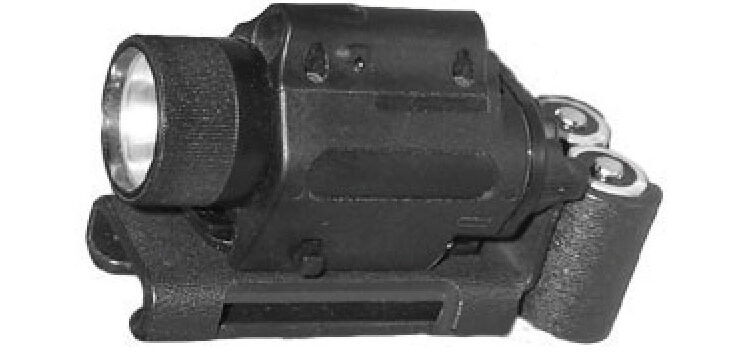By Aaron Brudenell
If the first rule of a gunfight is to bring a gun, before it even comes to that… you should already have a light! It’s widely understood that dangerous encounters are more likely at night and indoors, both of which have a high potential for being low light situations. Even when significant ambient light is present, shadows and the positions of participants may necessitate the use of a personal light. From target/threat identification to avoiding physical hazards to movement, the utility of such a light shouldn’t be ignored.
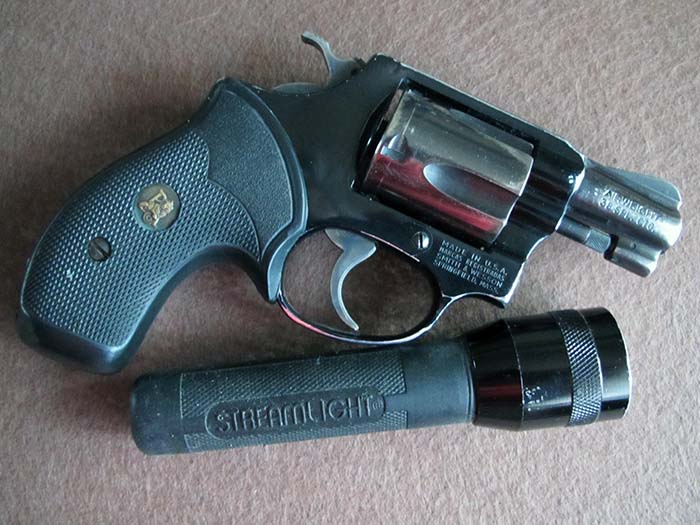
Eliminating Excuses:
Unlike a knife or firearm, a light will serve the user well in multiple circumstances where a weapon is not needed and can be taken into secure areas without special permission. Furthermore, quality flashlights tend to be of modest cost by comparison to guns and knives or multi-tools. Like knives and guns, lights can be had in virtually limitless variations of size, power, and control options. For these reasons, one should never omit a personal light from their everyday carry.
Since carrying a weapon is a serious matter, so it follows, one should put a comparable level of consideration when choosing a companion light as well. The reader should consider that any time they feel the need to choose a particular piece of security equipment the need for a comparable level of utility in a portable light should already have been selected:
- Service size handgun–full size/power flashlight
- Personal/patrol carbine–longer range, high powered, or weapon mounted light
- Compact concealable handgun–small discrete sized hand held light
- Small pocket gun–miniature pocket light
- Spare magazine/speed loader–fresh duplicate batteries
- Second knife/gun accessible by operator’s support/weak side–back up light carried in alternate location
- Weapon lanyard and/or secure carrier–holster/lanyard for retaining light
- Firearm parts kit for range repair–replacement bulb, clip, lanyard parts
- Flat Dark Earth gun and/or carrier–comparable option for light and/or carrier
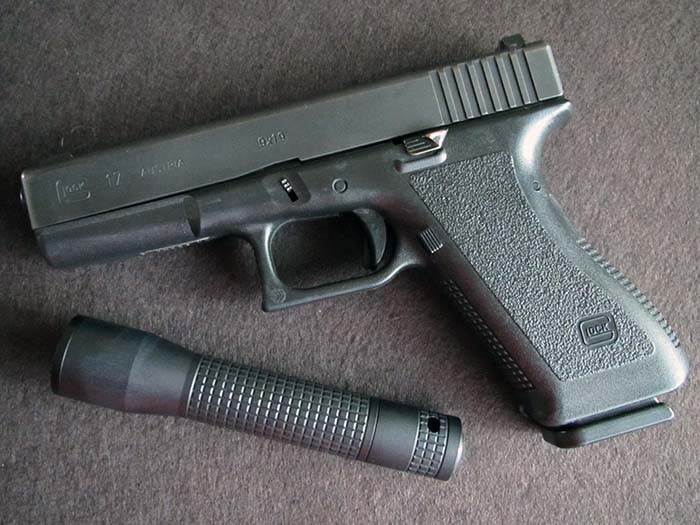
Options:
The main point of this article is that a serious gun carrier ought to insist on having a light with them at least as often as they are armed. Because adding a light imposes some burden of space, weight, and organization, the size of that choice often becomes the primary factor. Advice frequently given for firearms of choosing the biggest one you can use effectively and carry all the time is a great place to start. A bewildering array of small and powerful lighting products are available so a quick tour of the options is appropriate.
Controls:
Typical hand held lights are ~1” in diameter, 3-9” in length, and are activated by a push-button at the rear with a switch that goes on momentarily when partially compressed, and clicks to stay on when depressed all the way. This allows the operator to hold in a “fist up” orientation and control the output with the thumb of the support hand only. More complicated options exist that include strobe effects, variable output, and even programmable combinations with considerable variety.
These expanding features may seem tempting but without a similar increase in training and/or practice are sure to complicate their use when needed in a crisis. Most of us have little opportunity to train, practice, or engage in competition involving firearms in low light circumstances. If one chooses an unconventional or complicated light, they should spend some significant time getting used to deploying it alongside their weapon of choice even if all they can manage are dry-fire drills in the privacy of their home.
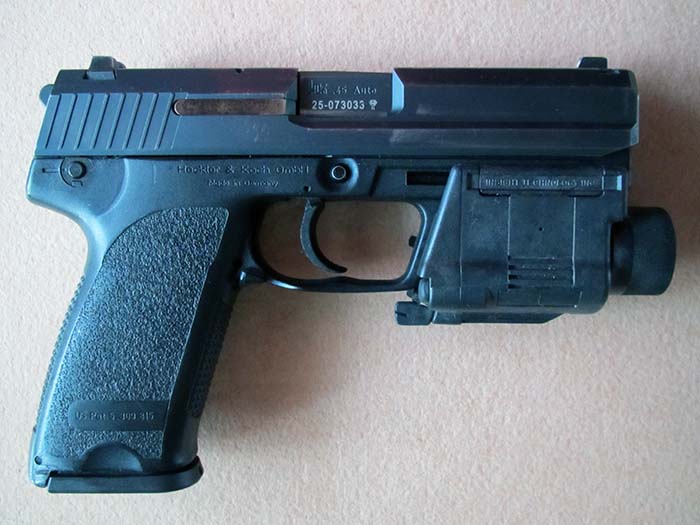
Quality:
Not all 1” rear pressure switch handheld flashlights are equal. An inexpensive model offered at the cash register of your local discount hardware store may look the part but not hold up to the rigors of daily carry and frequent use. The electronic connections, mechanical switches, threaded assemblies and lenses are all potential weaknesses if not properly constructed. Likewise, choosing good quality batteries or other consumables (e.g.-bulbs, lanyards, etc.) is equally important.
Brightness:
Without going into a lengthy discussion of output (often described in “lumens”), one should consider that the brightest light may not always be the best. The two main advantages of a high output light are increased range, which is less useful indoors, and the ability to temporarily blind or distract an adversary. On the other hand, a powerful light may generate more heat, consume batteries rapidly, draw fire or other negative attention, and in some cases produce reflections that can temporarily distract or blind the user.
Size:
Like concealable firearms, smaller lights tend to be favored for carry as long as they are capable of suitable output, duration, and can be successfully manipulated with one hand. A large light generally comes with greater battery life and if necessary can have additional utility as a blunt instrument to use as a contact weapon or to break glass as needed. Lantern lights with large flat bottom power sources and directional bezels can be positioned and directed for long term illumination into a hazardous approach or used to illuminate an area allowing the operator to use both hands as needed. The obvious portability limitation of a large light notwithstanding, one or more of them can be kept ready where there’s room enough to store a long gun.
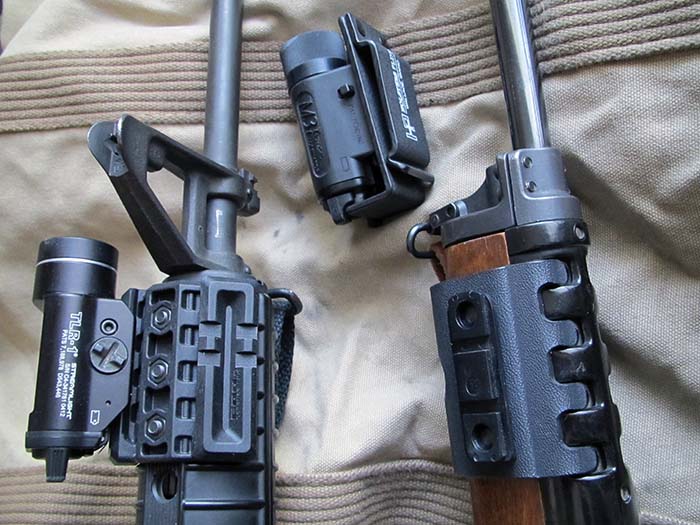
Weapon Mounted:
As to long guns with a light, most mounting solutions are accessible using the support hand some distance down the barrel (to limit its shadow). A number of storage compartments are also available for modern long guns that can hold cleaning kits and spare parts or ammunition. Some are designed specifically for spare batteries and light parts for good reason but those things can also be stored in non-standardized compartments or with an ammunition supply off the gun. While rarely employed, a secondary light in or on a rifle or shotgun remains an option and can permit multiple lights to solve different tactical problems. The most useful of these combinations are low output LED’s for discretely navigating a dark indoor space coupled with a high output tactical light for target illumination.
Handguns with mounted lights can rarely be carried without some kind of specialized holster that accommodates the light. Likewise, those same holsters tend to be less effective when the light is removed. Adding or removing a light from a sidearm is at best a 2-handed process requiring some fine motor control–both of which are problematic in a crisis. Whether on a pistol or long gun, some combinations permit quick removal of the light while others are more permanently mounted in place. The versatility of a removable light that can go from a rifle to a pistol or used as a handheld torch must be weighed against a more secure mount and weapon specific ergonomics. Having more than one light might be the better choice.
Weapon mounted lights are frequently activated by a pressure switch that allows constant or momentary illumination. Those that require grip compression may be problematic if the ergonomics promote fatigue or have a potential to relate sympathetically with the shooter’s firing hand. Pressure switches that have wires between them and the light will permit the user to fine tune the location of the activation but can snag during movement and manipulation. This writer prefers a thumb actuated switch directly on the light for these reasons.
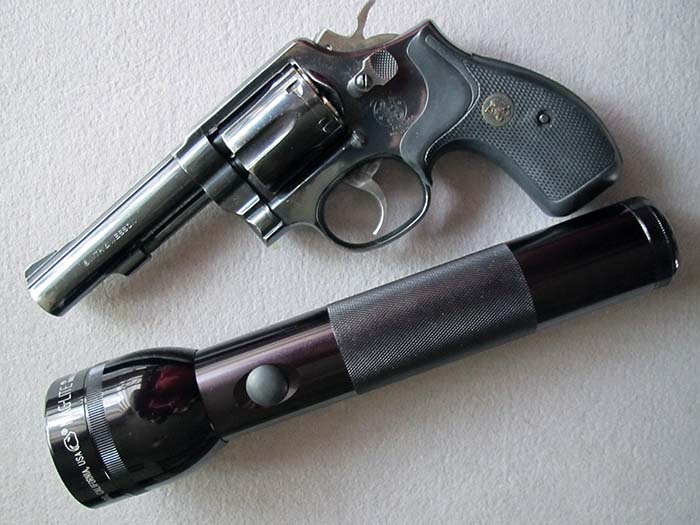
Techniques:
For normal use, most of us need little instruction on how to use a flashlight to find our car keys on the floor of a dark theater but using sound tactical techniques for such a task is good practice and may help you avoid irritating a fellow moviegoer. Tactical use generally means controlling and manipulating the light with one hand and judiciously limiting the path of the beam to items you need to illuminate for the minimal duration required to accomplish your task. Ironically, the greater skill with a tactical light lies in limiting the use so you don’t waste battery life or unnecessarily telegraph your location.
Limiting light exposure by only illuminating for brief periods and using the lowest available setting is the most common way. For circumstances where the light is overly bright for the situation, cupping your fist around the bezel can obscure most of the output and control the rest by releasing your grip at one end is another. A colored or semi-opaque lens cover can dull the output of a light and if attached to a flip open lens cover can be rapidly moved in and out of the beam path. It also helps to keep in mind that the closer one can get to something the better the light will be at illuminating it effectively. Another significant skill is combining moving and light activation to avoid being targeted. If avoiding potential threats, even if not actively engaging them, moving just after deactivating a light is a sound practice. If moving with a light on, altering direction for subsequent movement with the light off will help prevent tracking. Keeping the beam spot of a light farther from the operator prevents targeting from angles behind the user and when going to or from low ready it’s important to only activate light when on target so that the moving beam spot doesn’t track back to a user’s feet.
When searching continuously with a light it’s important not to crowd cover for the same reasons. A beam spot can reflect back to the source if close and passively illuminate it from the surface. Lighter surfaces will reflect more intensely than darker ones and reflective surfaces can cause additional sources of secondary illumination. An astute observer may also see the shrinking size of a beam spot and deduce the approach of the source as it moves. Handheld lights not attached to a weapon allow the user to place some distance between their cover or firing position if they extend the light arm above or to the side of their location. If taking a stationary position, the light can be turned on and rolled out away from the shooter or otherwise placed so that they illuminate a target area from another angle and source. Placing a light in a hallway and backing away from it will offer some concealment even if cover is not available. Likewise, leaving the light entirely and taking up a different position can distract opponents. These tactics are even more sound if one has a secondary light at their disposal so they don’t have to abandon their only source of illumination.
Additional Considerations:
Using a light as an impact weapon or visual assault on an aggressor can be an intermediate step in a force continuum prior to employing a firearm. Scalloped bezel surfaces may enhance an impact effect; however, this often comes at the cost of reclassifying the item as a weapon in certain jurisdictions (such as TSA regulations for air travel). Law enforcement training has trended away from teaching the use of a hand held light as an impact weapon so the user ought to limit plans for that circumstance or seek out dedicated martial arts training for that purpose.
The majority of new lights employ LED sources instead of traditional incandescent bulbs. LED’s are more durable, consume less battery life, generate less heat, and their color can be selected from the lighting elements used in manufacturing. Multiple LED’s can be employed in their construction to give output and programable options. The colors of these lights and beam spots tend to be more monochromatic than incandescent bulbs and those peculiar colors may have unpredictable reflection colors when shone on fluorescent or unusual surfaces.
Any small light will have a finite battery life and tiny pocket tactical models may have a battery life on the order of minutes. If sitting unused until emergencies, they can be counted on to deliver that life unless the batteries are particularly old or experience corrosion. If a light is in normal use there are no “fuel gauges” to let the user know their power source is near empty. Another hazard is inadvertently switching the light on in a pocket or holder–choosing a carrier that prevents this is well worth the expense and real estate on one’s belt. This particular unit from Holster’s Plus (see: http://www.holstersplus.com/collections/light-holders/products/m3-batt-pack and “batt-pack_grande.jpeg” image) will hold a removable weapon mounted light and two spare batteries while locking the switch in place.
Tactical illumination is not without drawbacks. Weapon mounted lights can loose the deterrent effect if their brightness conceal the handgun attached to them. Dust and muzzle gasses from firing can be lit like a fog obscuring targets from the user while silhouetting their position for adversaries. Reflective surfaces like glass and mirrors have the potential to blind the user or their teammates during a search. Weapon handling while using a light requires an extra dimension of skill but there are fewer opportunities to train and practice under low light conditions. If one has a light in a tactical situation, the correct approach may be to stay dark and avoid giving away their location. Without that light; however, there is no option to use it!
| This article first appeared in Small Arms Review V20N10 (December 2016) |



